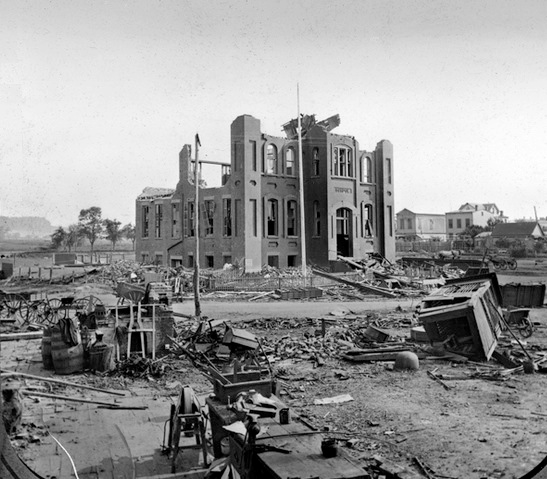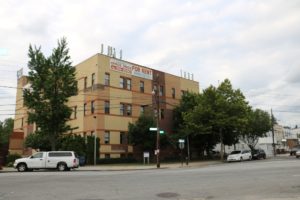William Schmidt owned a saloon and hotel at the south-east corner of Rockaway and Atlantic. Above the bar he kept a clock and it was said he always kept the time just right.
When the cyclone struck, the front window of his establishment exploded, sending shards of glass and splinters of flying. The debris struck the clock and it never ran again.
And that is how we know that the Great Cyclone of July 13th, 1895 – 127 years ago next week – struck Woodhaven at 4:19 p.m.
It had come from the west, originating in New Jersey, sweeping through East New York and uprooting trees and toppling tombstones in Cypress Hills cemetery. By the time it was done, it caused over half a million dollars worth of damage, and that’s in 1895 dollars!
It first hit Woodhaven at Jamaica Avenue and Elderts Lane, near the future home of Franklin K. Lane. Passengers on the Brooklyn, Queens County and Suburban Railroad, which had just been electrified the year before, huddled inside their derailed cars, sparks flying everywhere, as telegraph and trolley poles came crashing down around them.
One woman was trapped inside an outhouse as it was hurled more than a block away; miraculously, she suffered only cuts and bruises. A cow was swept up in the air and carried off, never to be seen again. Trees and chimneys were ripped from their foundations and flew through the air as if they were no heavier than feathers.
The worst scene of destruction was at the newly built 2-story brick schoolhouse at University Place (95th Avenue) and Rockaway Road (today, a Boulevard). PS 59 had been built in 1890 on land purchased from famed manufacturer Florian Grosjean, whose clocktower on the border of Woodhaven and Ozone Park still stands today.
The roof of the PS 59 was ripped off and the upper-half of the building collapsed. One block east of the school, 16-year old newlywed Louise Petroquien was at her sewing machine when she looked out the window and saw the massive dark cloud approaching and ran outside to warn her mother.
She emerged from a side doorway but before she could shout out a warning, a large beam torn from the roof of PS 59 slammed into her head and neck, killing her instantly.
In the days following the storm, over 100,000 people came to Woodhaven via the Long Island Railroad on Atlantic Avenue to view the damage. While locals bustled about, clearing away debris, visitors dropped coins and bills into barrels set up for the close to three hundred people who lost everything, or nearly everything, to the storm.
The main attraction for the visitors, however, was the home of Ms. Petroquien. The family permitted visitors to enter her home, through the door which she had rushed out of, stepping over the very spot where she lost her life.
They were led into the parlor where they could view and pay respects to the young bride, who was laying in a rosewood coffin under a large pile of flowers that visitors could buy outside for ten cents. When the pile got too big, flowers were taken back outside where they were re-sold.
Another victim of the storm was 5-year old Johnny Kolb. The boy had been playing on Atlantic and Rockaway when the storm hit and afterwards he was discovered lying under the rubble by PS 59 School Superintendent William F. Buckley.
Buckley was also a member of the Woodhaven Volunteer Fire Department and had heard the cries for help from the young boy. He carried Johnny Kolb inside where a doctor examined him and found that the boy had broken both an arm and a leg.
However, the next day, his condition took a turn for the worse and he passed away, bringing the number of Woodhaven fatalities to two. Both Louise Petroquien and Johnny Kolb were buried in Cypress Hills cemetery on the same day.
Today, the intersection of 83rd Street and Rockaway is now part of Ozone Park. There is nothing to indicate that this was once the scene of a powerful and destructive storm. An office building stands where the school once sat; for many years, this building was well known as a Friendly Frost appliance store.
Only that this storm struck on a Summer Saturday afternoon prevented this from being a far more tragic tale. Had this happened on a school day, with a building full of children, we’d be writing a far different story 127 years later.




